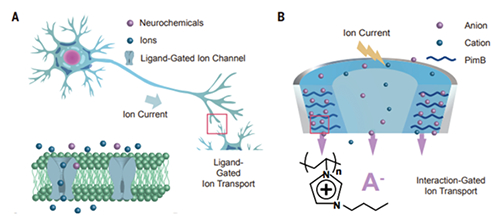
Figure. Schematic illustration of neural functions realized by biological neurons (A) and PFM (B).
With the support of the National Natural Science Foundation of China (Grant Nos. 21790390 and 22125406), the research teams of Prof. Lanqun Mao from Institute of Chemistry, Chinese Academy of Sciences/Beijing Normal University and Prof. Ping Yu from Institute of Chemistry, Chinese Academy of Sciences developed a polyelectrolyte-confined fluidic memristor (PFM), which could emulate diverse electric pulse with ultralow energy consumption. Moreover, benefitting from the fluidic nature of PFM, chemical-regulated electric pulses and chemical-electric signal transduction could also be emulated. The article entitled ''Neuromorphic Functions with a Polyelectrolyte-confined Fluidic Memristor" was published in Science on January 12, 2023. (Science, 2023, 379, 156-161. http://www.science.org/doi/10.1126/science.adc9150)
Neuromorphic devices have attracted numerous attention because of its potential application in neuromorphic computing, intelligence sensing, brain-machine interfaces and neuroprosthetics. However, most of the neuromorphic functions achieved so far are based on the mimic of electric pulses with solid state devices. Mimicking the functions of chemical synapses, especially neurotransmitter-related functions, is still a long-standing challenge in this research area.
The research team first fabricated the polyelectrolyte-confined fluidic channel using surface-initiated atomic transfer polymerization. By systematically studying the current-voltage relationship, they found that the fabricated fluidic channel well satisfied the nature memristor, which was defined as PFM. The ion memory was originated from the relatively slow diffusion dynamics of anions into and out of the polyelectrolyte brushes.
The PFM could well emulate the short-term plasticity patterns, including paired-pulse facilitation and paired-pulse depression. Moreover, these functions can be operated at the voltage and energy consumption as low as those biological systems, suggesting the potential application in bioinspired sensorimotor implementation, intelligent sensing and neuroprosthetics. The PFM could also emulate the chemical-regulated STP electric pulses. For example, 1 mM adenosine triphosphate (ATP) would change the retention time of PFM from 156 ms to 138 ms. This result indicates that the PFM may allow direct interfacing and communicating with biological systems, given that its neuroplastic behaviors are controllable by bioactive molecules.
More importantly, based on the specific interaction between polyelectrolytes and counterions, the chemical-electric signal transduction was accomplished with the PFM, which is a key step towards the fabrication of artificial chemical synapses. With structural emulation to ion channels, PFM features versatility and easily interfaces with biological systems, paving a way to building neuromorphic devices with advanced functions by introducing rich chemical designs. This study would open a new door for interfacing the chemistry with neuromorphic device.

Add: 83 Shuangqing Rd., Haidian District, Beijing, China
Postcode: 100085
Tel: 86-10-62327001
Fax: 86-10-62327004
E-mail: bic@donnasnhdiary.org
京ICP备05002826号 文保网安备1101080035号 Copyright 2017 NSFC, All Right Reserved